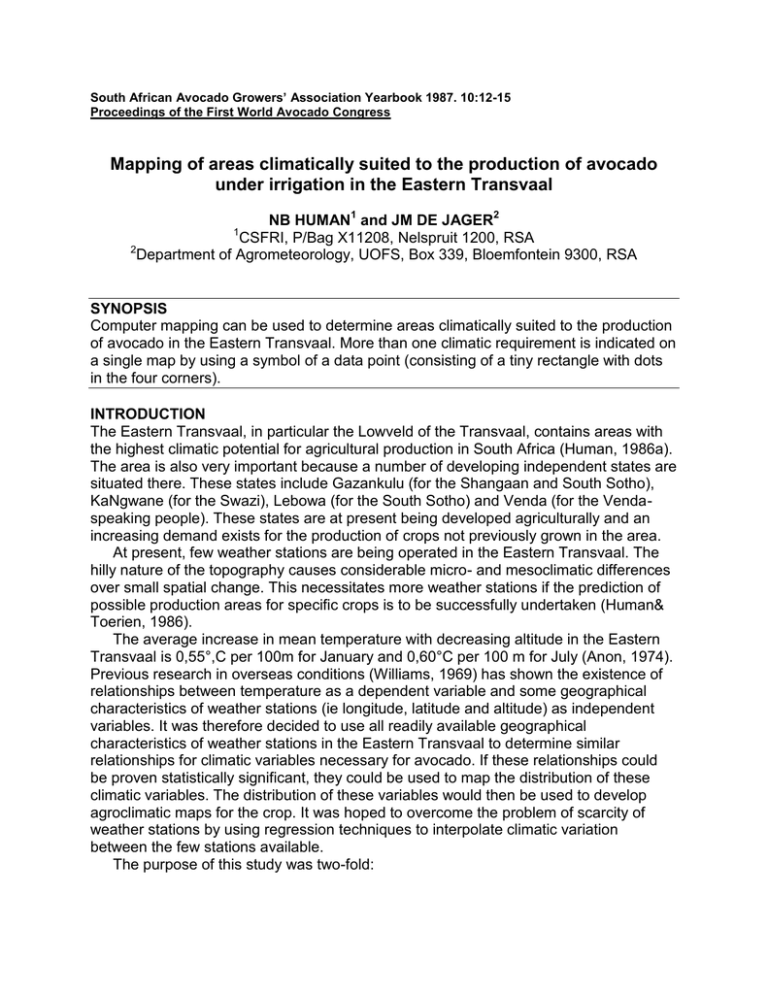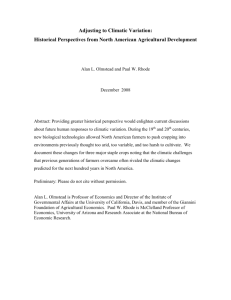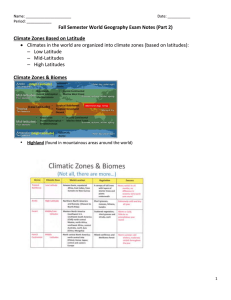South African Avocado Growers’ Association Yearbook 1987. 10:12-15
advertisement

South African Avocado Growers’ Association Yearbook 1987. 10:12-15 Proceedings of the First World Avocado Congress Mapping of areas climatically suited to the production of avocado under irrigation in the Eastern Transvaal NB HUMAN1 and JM DE JAGER2 CSFRI, P/Bag X11208, Nelspruit 1200, RSA 2 Department of Agrometeorology, UOFS, Box 339, Bloemfontein 9300, RSA 1 SYNOPSIS Computer mapping can be used to determine areas climatically suited to the production of avocado in the Eastern Transvaal. More than one climatic requirement is indicated on a single map by using a symbol of a data point (consisting of a tiny rectangle with dots in the four corners). INTRODUCTION The Eastern Transvaal, in particular the Lowveld of the Transvaal, contains areas with the highest climatic potential for agricultural production in South Africa (Human, 1986a). The area is also very important because a number of developing independent states are situated there. These states include Gazankulu (for the Shangaan and South Sotho), KaNgwane (for the Swazi), Lebowa (for the South Sotho) and Venda (for the Vendaspeaking people). These states are at present being developed agriculturally and an increasing demand exists for the production of crops not previously grown in the area. At present, few weather stations are being operated in the Eastern Transvaal. The hilly nature of the topography causes considerable micro- and mesoclimatic differences over small spatial change. This necessitates more weather stations if the prediction of possible production areas for specific crops is to be successfully undertaken (Human& Toerien, 1986). The average increase in mean temperature with decreasing altitude in the Eastern Transvaal is 0,55°,C per 100m for January and 0,60°C per 100 m for July (Anon, 1974). Previous research in overseas conditions (Williams, 1969) has shown the existence of relationships between temperature as a dependent variable and some geographical characteristics of weather stations (ie longitude, latitude and altitude) as independent variables. It was therefore decided to use all readily available geographical characteristics of weather stations in the Eastern Transvaal to determine similar relationships for climatic variables necessary for avocado. If these relationships could be proven statistically significant, they could be used to map the distribution of these climatic variables. The distribution of these variables would then be used to develop agroclimatic maps for the crop. It was hoped to overcome the problem of scarcity of weather stations by using regression techniques to interpolate climatic variation between the few stations available. The purpose of this study was two-fold: Firstly, to use long-term weather data from all available past and present weather stations in the area to determine the relationships between the climatic requirements of avocado and the geographical characteristics of the weather stations (ie latitude, longitude, altitude and distance to the sea). Secondly, to use these relationships to map climatic regions suitable for the growing of avocado. A literature survey was conducted (Human, 1986a) to determine the climatic requirements of six subtropical crops. One of these crops was avocado (Persea americana Mill). A summary of the literarily determined climatic requirements of this crop is given in Table 1. All values used are long-term monthly means of daily values. Table 1. Literarily determined climatic requirements of avocado Maximum temperature (oC) <35 (summer) Climatic requirements Minimum temperature (oC) >5 (winter) Minimum RH (%) >20 (Jul-Oct) PROCEDURE The area studied was the Eastern Escarpment and the Eastern Lowveld, as defined by the South African Weather Bureau (Anon, 1974 and Anon, WB 33). It is roughly situated between 30° and 32° east longitude and 22° and 27°30' south latitude, excluding Mozambique and Swaziland. Production areas of avocado (Human, 1986b) in this area were mapped (Figure 1). Climatic data (for a minimum period of five years) for past and present weather stations, situated between the longitudes of 30° and 32° east, and latitudes 22° and 26° south were introduced into a statistical package (anon, 1984a) on a micro-computer. Multiple linear regressions were used to determine the relationship between a particular weather factor (eg the maximum temperature for the hottest summer month) and the physical characteristics of the station sites (ie longitude, latitude, altitude and distance to the sea). All values used were monthly means of daily values averaged over the long term. A grid comprising data points of longitude, latitude, altitude and distance to the sea were obtained from the Computing Centre for Water Research of the University of Natal. This gave altitudes and distances to the sea at the intersections of a square grid of latitude and longitude lines at 2' intervals (a distance of approximately 3, 4 km) over the study area. These data points were then used to generate hypothetical weather stations at every point using the multiple linear regression equations. These stations gave the expected. maximum and minimum temperatures, minimum relative humidities and evaporation for the point. Maps of these climatic factors were then plotted by microcomputer. Fig 1 Existing production areas of avocado in the Eastern Transvaal (denoted by shading). The climatic requirements of avocado, as defined in Table 1, were used in conjunction with these maps to determine the regions climatically suited to the crop. A statistical package (Anon, 1984a) was used on a Columbia (IBM-compatible) micro-computer to determine multiple linear regression relationships between geographical characteristics of the weather stations (ie longitude, latitude, altitude and distance to the sea) and the following nine climatic factors: minimum temperature for the coldest winter month (factor 1) highest maximum temperature during winter (factor 2) lowest minimum temperature during summer (factor 3) highest maximum temperature during summer (factor 4) highest minimum relative humidity for the period October to December (factor 5) lowest minimum relative humidity during summer (factor 6) lowest minimum relative humidity for the period July to October (factor 7) highest daily evaporation rate during summer (factor 8) lowest maximum temperature during summer (factor 9). The months December, January and February were taken as the summer months and June, July and August as winter. Seventy-five weather stations (Human 1986b) were used in this study and the following procedure was followed: Data sets were constructed, using a simple BASIC programme on the microcomputer. Data from all available weather stations with data of five years' duration or longer, were used (Anon, 1986b and Anon, 1986c). These consisted of columns of climatic factor, longitude, latitude, altitude and lastly distance to the sea for that particular weather station. The statistical package was then used to determine the multiple linear regression relationships. If the corrected R2 and the F-test values showed significance at the 5 per cent level or better, the relationship was accepted and used for the plotting routines. If the relationship did not show significance at the 5 per cent level, residual file output was specified when using the statistical package. These residual files were then used to determine which weather stations showed the biggest difference between their true and predicted values. If some of the stations showed excessively big differences, their locations were inspected. If they were located on a site not representative of the meso-climate of the area, they were removed and the regression re-run. This was repeated until regression equations were found, showing significance at the 5 per cent level or better. To be theoretically correct, locations of stations, of which the data were removed, were blocked out on the agro-climatic maps. This was done because these sites were identified as locations where the mapping method did not give a true account of the climate. The relationships are described by multiple linear regression equations of the following format: Y = B0 + B1X1 + B2X2 + B3X3 (1) where: Y = one of the climatic factors as described above Xt = longitude X2 = latitude X3 =altitude (m) X4 = distance to sea (m) and B0, B1, B2, B3 and B4 = constants. RESULTS AND DISCUSSION A summary of the values of the constants for the multiple linear regression equations are given in Table 2. A summary of the output of the statistical package (Anon, 1984a) is given in Table 3. Maps were drawn (Human, 1986b) on a Roland DXY-880 multipen plotter, using software developed for this purpose, in the computer language GW(TM)-BASIC (Anon, 1984c). Maps of the predicted values were drawn on transparencies. A different colour pen was used at each specified interval, for each climatic factor previously defined. These maps were then superimposed upon the map of the existing avocado production areas in the study area (Figure 1) and the climatic requirements, as determined in the literature survey (Table 1), verified. Where differences between the two sets of climatic requirements were seen, the literarily determined climatic requirements were modified. The new climatic requirements, thus deduced, are listed in Table 4. The final step was to write a programme on the micro-computer using the climatic requirements in Table 4 to map all possible production areas for avocado within the study area. The programme was written to construct a rectangle around every data point used. In the corners of each rectangle a dot specifies whether the climatic requirements for avocado are met for that specific data point. An open rectangle indicates where none of the climatic requirements for the crop are met (Figure 2). TABLE 2 Coefficients for the multiple linear regression equations. Weather factor 1 2 3 4 5 6 7 8 9 B0 -78.09032 -123.8897 -62.50364 -22.62833 -36.94903 124.8512 16.25463 -42.20582 -8.48780 B1 2.853623 4.931896 2.565737 1.74229 -2.653427 -4.660088 -1.6409 1.633031 1.2873 Coefficient B2 -0.9181572 9.2575E-4 0 0 6.248015 2.476279 2.767154 -0.11601 0 B3 -3.2019E-3 -7.1320E-3 -4.0433E-3 -5.6651E-3 -4.1146E-3 -1.8753E-3 -4.2848E-3 -7.5635E-5 -5.5531E-3 B4 1.9323E-5 1.5418E-5 1.2852E-5 8.9358E-6 4.5776E-5 -3.4642E-6 -6.9101E-6 5.3587E-6 5.4457E-6 TABLE 3 Statistical analysis of the multiple linear regression equations. R2 (corrected) Weather factor Level of Value Std. error significance 1 0.64 *** 1.62 2 0.87 *** 1.73 3 0.76 *** 1.31 4 0.86 *** 1.15 5 0.64 *** 2.82 6 0.55 *** 2.23 7 0.59 *** 2.53 8 0.67 *** 0.38 9 0.84 *** 1.16 LEGEND: + Durbin-Watson test ***significance at the 1% level **significance at the 5% level F-test D-W+ 2.14 1.76 1.99 2.29 1.90 2.07 2.18 1.67 2.31 Value 28.72 124.41 78.75 151.97 7.69 5.84 8.49 8.20 134.62 Level of significance *** *** *** *** ** ** ** ** *** A series of computer programmes (called MAPS, ie Mapping of Areas for the Production of Subtropical crops) were written. They are for use on IBM-compatible micro-computers and will enable interested parties to map for their own specific purposes. All programmes are driven by menus that are self-explanatory and easy to use (Human 1986b). Fig 2 Areas in the study area climatically suitable for the growing of avocado. CONCLUSIONS It was shown that statistically significant (P<0,05 and in most cases P<0,01) multiple linear regression relationships exist between nine climatic factors and longitude, latitude, altitude and distance to the sea. The climatic factors used were: minimum temperature for the coldest winter month highest maximum temperature during winter lowest minimum temperature during summer highest maximum temperature during summer highest minimum relative humidity for the period October to December lowest minimum relative humidity during summer lowest minimum relative humidity for the period July to October, and highest daily evaporation rate during summer. TABLE 4 Climatic requirements of avocado as calculated for the study area. Maximum temperature (oC) <31 (summer) Climatic requirements Minimum temperature (oC) >4 (winter) Minimum RH (%) >20 (Jul-Oct) Mean monthly long-term values over a minimum period of five years for daily values were used. The coefficients of determination for the four independent variables on temperature, showed that altitude generally had a greater effect than longitude, latitude and distance to the sea. Minimum relative humidity longitude, latitude and altitude and evaporation longitude and distance to the sea contributed most to the coefficients of determination of their regression relationships. Computer programmes were written, using the multiple linear regression equations and a square grid of data points, to map climatic regions suitable for the production of avocado. ACKNOWLEDGEMENTS The authors wish to acknowledge the contributions of: The CCWR (Mr M Dent and Mrs K Wiercx) for the grid of data points. The SA Weather Bureau (in particular Mrs Rademeyer and Mrs Swart) for supplying weather data. Dr A Joubert for his continuing assistance. Mr A Toerien for his assistance with computer-related problems. Dr J Bower and Mr B Durand for horticultural assistance. Mrs S Kunneke, Miss A Scholtz and Mrs E Smith for their assistance in data management. Mr F Koch for making weather data available and other technical assistance. REFERENCES 1 Anon, 1974. Climate of South Africa (W B 28). Weather Bureau, Pretoria, 330 pp. 2 Anon, 1984a. NWA Statpak (Version 3,1). Portland, Oregon. 3 Anon, 1984b. Columbia BASICA 2,0. Columbia, MD. 4 Anon, 1984c. NCR GW(TM)-BASIC. Dayton, Ohio. 5 Anon, 1986a. Climate of South Africa. Climate Statistics up to 1984 (WB 40). Weather Bureau, Pretoria, 474 pp. 6 Anon, 1986b. Weather and climate statistics. Department of Agriculture, Agrometeorology, CSFRI, Nelspruit. 7 Anon, 1 986c. Weather and climate statistics. Weather Bureau, Climate Branch, Pretoria. 8 Anon, WE 33. Hier is die weervoorspelling. South African Weather Bureau, Pretoria, 3 pp. 9 Human, NB, 1986a. Delimitation of areas climatically suitable for six irrigated subtropical crops in the Eastern Transvaal. Unpublished MSc (AGRIC) thesis. University of the Orange Free State, Bloemfontein, 114 pp. 10 Human, NB, 1986b. Agro-climate of the Eastern Transvaal. 1 A literature survey of the climatic requirements of six subtropical crops. Horticultural Science, 4, 1-5. 11 Human, NB & Toerien, A, 1986. Agro-climate of the Eastern Transvaal. 2 A mapping technique. Horticultural Science, 4, 7-11. 12 Williams, GDV, 1969. Applying estimated temperature normals to the zonation of the Canadian Great Plains for wheat. Canadian Journal of Soil Science, 49, 263-276.



